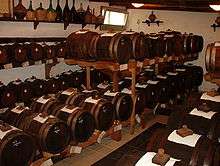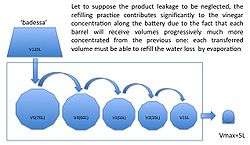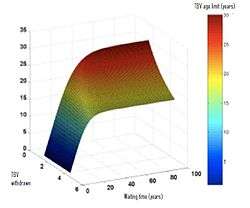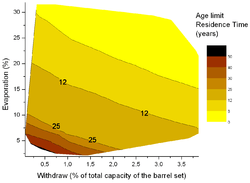Traditional Balsamic Vinegar
Traditional Balsamic Vinegar (or Aceto Balsamico Tradizionale) is a type of balsamic vinegar produced in Modena and the wider Emilia Romagna region of Italy. Unlike inexpensive "Balsamic Vinegar of Modena" (BVM), Traditional Balsamic Vinegar (TBV) is produced from cooked grape must, aged at least 12 years, and protected under the European Protected Designation of Origin (PDO) system, fetching higher prices.[1] (BVM has lesser protection under the European Protected Geographical Indication (PGI) system.[2]) Although the names are similar, TBV and the inexpensive imitation BVM are very different.[3]

History
A comprehensive study of the original production procedures, the aging conditions, and the sensory profile is not available. This and the few and often-confusing documents make the reconstruction of the true history of TBV a challenge. The term balsamico derives from the Latin word “balsamum” and from the Greek word “βάλσαμον”, in the sense of "restorative" or "curative". The art of cooking the must of grapes dates back to the ancient Romans: it was used both as a medicine and in the kitchen as a sweetener and condiment.[4] The first generally accepted document referring to a precious vinegar produced in the area of Modena and Reggio Emilia is the poem written in the 12th century by the monk Donizo of Canossa,[5] although the word "balsamic" is never mentioned. The first testimonies clearly speaking about "balsamic vinegar", as well as of recipes and making procedure, appear from the 19th century even if little is known about the original recipes and related production practices.[6] The adjective "balsamic" has been used to designate any kind of generically aromatic vinegar and products not just obtained from the fermentation of grape must alone.[7] As far as the aging method is concerned, it is very similar to the Solera system used in Spain after the Napoleonic Wars which spread abroad after the second half of the 19th century.[8]
The oldest and most detailed description of the method and techniques for the production of balsamic vinegar is reported in a letter written in 1862 by Francesco Aggazzotti to his friend Pio Fabriani, in which he describes the secrets of his family's "acetaia" (the vinegar-cellar where balsamic vinegar is made).
_and_Reggio_Emilia_(left).jpg)
Legal aspects
TBV is produced in two different geographical areas of the Emilia Romagna Region so that two different designations were granted by the European Council, i.e. Traditional Balsamic Vinegar of Modena (TBVM) and Traditional Balsamico Vinegar of Reggio Emilia (TBVRE). The two special vinegars are very similar products as the overall making procedure is the same; but, from a legal point of view, they are obtained according to specific and official production regulations[9][10] defining (1) the basis of the vineyards ampelographic; (2) geographical area of production; (3) characteristics of starting materials; (4) making procedure; (5) the chemical, physical and sensorial requirements for sale; (6) bottling, labelling and presentation. The sensory profile of TBV is evaluated by hedonic judgment expressed through a numeric score. The sensory score achieved is used to rank TBV in different commercial classes. The specific regulations allow adding "Extra Vecchio" to the official designation when the product is aged for 25 years at least. However, under existing regulations, neither the definition of "aging" nor the methods for its objective evaluation are specified; it is evaluated only through panel-tasting tests, whose effectiveness for this purpose is clearly inadequate.[11] TBV results as a blend of vinegars of different composition and age due to the traditional making procedure. Actually, an easy-to-use mathematical method for evaluating the actual residence time of TBV within each cask of the barrel set has been recently published.[12] This method is an adequate tool helping aging certification. An easy-to-use spreadsheet of the theoretical model is available for download.[13] At present, however, independent agencies that officially state TBV authenticity of both the TBVM and TBVRE haven't adopted it or any analogous procedure as an evaluation system.
Basic technology
Making process of the TBV starts from freshly squeezed grape juice and finishes with sensory evaluation of the aged vinegar. From a technological perspective, basic steps are required, including cooking of the grape must, alcoholic fermentation by yeasts, acetic oxidation by acetic acid bacteria, and slow aging within a barrel set.
Cooking of the grape must
Cooking of the grape juice is carried out in open vessels directly heated by fire for 12 – 24 hours reducing the grape juice by about 50%. The production regulations require starting from a grape must with 15°Bx at least to reach at the end of cooking 30°Bx for TBVRE; for TBVM, the lower limit is not specified. It is possible to find cooked musts with sugar concentration beyond 50°Bx.[14] The operation allows profound chemical and physical modifications affecting the end quality of TBV. Cooking stops all enzymatic browning reactions that rapidly occur inside fresh grape musts by polyphenol oxidase and progressively promotes grape must discoloration due to the heat-induced deactivation of proteins including browning enzymes. In addition, cooking promotes nonenzymatic browning chemical reactions involving sugar conversion, formation of high molecular weight melanoidins[15] and furanic compounds such as 5-hydroxymethylfurfural (HMF).[16] Water vaporization induces the concentration of sugars, organic acids, and polyphenols, resulting in the increase of density, viscosity, and refractive index (Brix degree), and, conversely, the lowering of water activity and pH value.
Alcoholic fermentation
Sugar fermentation and ethanol oxidation occur as a two-step biological transformation of the cooked must. The first requires anaerobic conditions and the second aerobic conditions. The two biological conversions occur inside a dedicated vessel, called the badessa. The alcoholic fermentation is carried out by yeasts belonging to a plethora of species and genera.[14] In the past, the idea of a commensalistic interaction between yeasts and acetic acid bacteria existed, but recently the scalar fermentation has been suggested.[14] The alcoholic fermentation is widely accepted to affect the end quality of TBV due to the several yeasts' metabolisms involved.[14]
Acetic bioxidation
In TBV, the oxidation of ethanol to acetic acid in fermented cooked must is carried out by indigenous acetic acid bacteria naturally occurred in the environment. However, the application of selected acetic acid bacteria strains in TBV production has been recently proposed, and a procedure has been developed for the scale-up of the fermentation process at the vinegar factory scale.[17] Bacteria involved in alcoholic dehydrogenation produce a wide range of compounds other than acetic acid, such as sugar acids and many volatile compounds. So, the chemical composition of TBV, relating to the AAB oxidation products, is highly variable and depends on several factors such as the type of grape must, cooking modality, oxidation temperature, and others. The acetification process and the growth of relevant bacteria are mainly affected by the alcohol, sugar, and acetic acid content.[18]
Aging
The aging is related to two basic concepts.[19] The first concerns the time that vinegar spends inside the barrel set (age or residence time); the second accounts for all time-dependent changes in chemical, physical and sensorial properties (physical ripening time).
The barrel set
The barrel set is a series of at least five wooden casks arranged according to a decreasing size scale, where the product undergoes profound changes over time. Casks may be of different wood types, i.e. oak, mulberry, ash, chestnut, cherry, juniper, and acacia, and the smallest cask volume ranges from 15 to 25 liters. Each cask has a hole on the top, the so-called cocchiume, facilitating the usual inspection and maintenance activities. The barrel set behaves essentially as a device for vinegar concentration due to water loss through the staves. As widely known for the wine production, it is reasonable to suppose that the wood acts as a semipermeable filter for the transfer of small molecules towards the ambient while it retains important volatile compounds such as the acetic acid. However, when the opening is not hermetically closed, the volatile compounds are lost preferentially through the cocchiume itself.[20]
Refilling procedure

The making procedure of TBV is a semicontinuous process requiring the annual refilling activity, consisting of withdrawing only a part of the vinegar from the smallest cask and topping it with the vinegar coming from the next cask along with the barrel set, and so on. The biggest cask receives new cooked and acetified must. This refilling procedure resembles the Solera method used for making sherry wine. The purpose of refilling in the TBV making is to keep the vinegar volume constant inside every cask in the barrel set, and compensate for the volume drop caused by these three factors: TBV withdrawn for bottling, water evaporation, and possible vinegar leakages from the staves. Refilling involves the product flux-splitting from the biggest to the smallest cask, leading to the solute dislocation along the barrel set.
Age and yield

Each cask of a barrel set contains a blend of vinegars with different compositions and ages due to the refilling procedure. As a consequence, the mean age of vinegar can be calculated as the weighted residence time of the different aliquots of vinegars introduced through the years. A theoretical model has been recently developed to estimate the mean age of TBV requiring refilling, withdrawn, and casks volumes as input data.[12] The refilling procedure imposes an upper limit for the residence time of the vinegar inside the barrel set. The yield of a barrel set used for TBV production is easy to calculate by the ratio between the amount of TBV withdrawn (mTBV) and the amount of cooked must (mREFILLING) used to refill the biggest cask:


Yield indicates the ability of a barrel set to concentrate cooked must at given operating conditions being dependent on the rate of water loss by evaporation. Low yields are due both to relatively low withdrawn and high water evaporation rates. The latter is the major factor lowering the TBV yield. The bigger is the evaporation rate, the higher is the flux of material through the barrel set and the lower is the residence time.[21][22] As a consequence, when the yield is low, the vinegar age might be relatively low as a function of the amount of cooked must used to refill.[23] Applying the spreadsheet of the theoretical model[13] to a barrel set as in figure, the residence time obtained as a function of withdrawn quantity and evaporation rate is plotted in the concerning graph.
Chemical composition
| Major compounds | Mean (g/Kg) | SD |
|---|---|---|
| Soluble solids | 739 (73.9°Bx) | ±10.5 |
| Glucose | 230.60 | ±30.45 |
| Fructose | 210.14 | ±30.37 |
| Tartaric acid | 7.8 | ±2.5 |
| Succinic acid | 5.0 | ±7.0 |
| Acetic acid | 18.8 | ±4.5 |
| Malic acid | 10.4 | ±3.2 |
| Gluconic acid | 18.7 | ±12.7 |
| Lactic acid | 1.2 | ±0.7 |
| Volatile compounds | Median (mg/kg) | SD |
| Alcohols | 18.4 | - |
| Aldehydes | 1.94 | - |
| Acids | 15.4 | - |
| Acetates | 2.61 | - |
| Esters | 0.71 | - |
| Enolic derivatives | 1.36 | - |
| Furanic compounds | 1773 | - |
| Ketones | 0.77 | - |
| Lactones | 4.5 | - |
| Phenols | 105 | - |
| Terpenes | 10.01 | - |
| Antioxidant molecules | Mean (mg/kg) | SD |
| Phenolic acids | 606.0 | 7.9 |
| Flavanols | 304.2 | 13.0 |
| Flavonols | 241.4 | 14.9 |
| Tannins | 349.0 | 19.5 |
| Major compound data from[24] | ||
| Volatile compounds data from[25] | ||
The composition of TBV is very complex and not yet fully described. The classes of the major components are the sugars[26] (mainly glucose and fructose) and organic acids[27] (mainly acetic, gluconic, malic, tartaric, succinic acids). The classes of the minor compounds refer to volatile compounds[28] and antioxidant molecules[29] mainly polyphenols.[30] An important class of minor compounds, recently investigated, is that known as melanoidins, an heterogeneous mixture of polymers arising from sugar degradation reactions activated during cooking of the grape must. These polymers contribute to many physical properties of TBV including colligative ones, the refractive index, density, specific heat capacity melt, and rheological properties.[31]
Physical properties
The most relevant physical properties of the TBV are:
- pH is usually lower than 3; it is a measure of the extent of carboxylic acids dissociation.
- Density is usually intended as mass density at 20 °C, it cannot be lower than 1.24 g/ml (TBVM)[9] and 1.20 g/ml (TBVRE);[10] it is a measure of the extent of the solute concentration, as well as of water evaporation.
- Refractive index is usually expressed with Brix scale and reaches on average 73°Bx.
- Color ranges from yellow/brown to brown/black during aging because of the accumulation of compounds, mainly melanoidins, from nonenzymatic reactions such as acid-catalyzed sugar degradation and Maillard reactions.[31]
- Viscosity is a macroscopic measure of the degree of intermolecular interaction inside the vinegar bulk and is easily determined as the resistance to flow under controlled experimental conditions. The viscosity of TBV is on average around 0.56Pa⋅s[32] and determines the TBV fluency as visually assessed according to procedures in use to assign sensory judgements.
- Flow index indicates the deviation of the flowing properties from the linearity (Newtonian behavior).[32]
TBV compared to BVM and other balsamic products
From a legal point of view, TBV is categorized as 'food condiment', while BVM is a 'wine vinegar'. BVM can be produced without an aging period, whereas TBV gains its particular features during a long aging period fixed by law at no less than 12 years. TBV is the only condiment in the world produced starting from cooked grape musts without the adding of other substances,[24] whereas BVM is a blend of concentrated grape musts, wine vinegars, and caramel (optional).
| Traditional Balsamic Vinegar | Balsamic Vinegar of Modena | Other balsamic condiments | |
|---|---|---|---|
| PRODUCTION | |||
| Starting materials | Cooked must from grapes harvested in Modena or Reggio Emilia provinces of permitted vine cultivars | Concentrated and sulphitated grape musts, wine vinegar and optional caramel (max 2% w/w) - the basis of vineyards ampelographic is imposed by law, but the permitted vines can grow outside the Modena province | Depending on recipes, they may contain concentrated must, but thickeners such as modified or native starch, glucose/fructose syrup, pectins, guar gum, xanthan, carob seed, etc. are always added) |
| Making procedure | Alcoholic fermentation of sugars, acetic oxidation, aging period inside a set of wooden casks, refilling procedure throughout the years, annual withdrawal and bottling. The overall procedure is carried out on a small scale. | Mix of the starting materials, facultative maturation in a single barrel and bottling. The overall procedure is carried out on an industrial scale. | Mix of the starting materials and packaging. The procedure is carried out at industrial scale. |
| Legal aging | The residence time of the product inside the set of barrels is determined by the refilling and withdrawing procedure. The minimum aging time is no less than 12 years. | The minimum aging time is no less than 60 days. | No minimum limit for aging. |
| PRESENTATION | |||
| Bottling | The product is sealed inside the patented 100-ml glass bottle | The product is sealed inside various kind of bottles (minimum 250 ml of capacity) or single-dose plastic packages (maximum 25 mLml) | The product is sealed inside various kinds of packages of different capacity |
| Pricing[33] | Ranging between 40 and 250 euros | Ranging between 2 and 40 euros | Ranging between 2 and 350 euros |
| CHARACTERISTICS | |||
| Minimum density | TBVM 1.24g/ml - TBVRE 1.20g/ml The relatively high density is the result of the water evaporation during the long aging period. | 1.06g/ml Higher density values depend on the degree of grape must concentration. | Not required: Higher density values are possible as a function of recipes. |
| Minimum of total acidity | TBVM 4.5g/100g - TBVRE 5g/100g of acetic acid equivalent, the acetic acid is biologically produced in the early stages of making procedure, then it concentrates during aging. | 6g/100g of acetic acid equivalent. The acetic acid comes from the starting ingredients. | Not required |
| Colour | Dark brown, limpid and bright, color is determined by nonenzymatic browning reaction of sugars starting on grape must cooking stage and progressing during aging. | Dark brown, limpid and bright, brown colour can be enhanced by added caramel (E150d) | Dark brown, limpid and bright, brown colour can be enhanced by added caramel (E150d) |
| Viscosity | The viscosity of TBV is mainly affected by the amount of the high molecular weight melanoidin, a heterogeneous class of biopolymers that form and accumulate during the ageing process.[31] | Viscosity is lower than TBV ones, although it can be enhanced by adding caramel. | The flow properties are very similar to the TBV ones, but they originate from the adding of thickeners. |
| Sensory evaluation | It is a prerequisite for their commercialization. Sensory panels are long-time, trained judges, but sensory procedures are not standardized, often leading to irreproducible scores.[34] | Not required | Not required |
References
- EC Council Regulation No. 813/2000
- EC Council Regulation No. 583/2009
- Giudici, P.; M. Gullo; L. Solieri; P. M. Falcone (2009). Technological and Microbiological Aspects of Traditional Balsamic Vinegar and their influence on Quality and Sensorial Properties. Advances in Food and Nutrition Research, vol. 58.
- History of Balsamic Vinegar http://www.italiaregina.it/balsamic-vinegar
- Donizo, Acta Comitissae Mathildis (Retrieved from: Donizone, 2008. Vita di Matilde di Canossa. (Golinelli, P. Ed.). Jaca Book
- Benedetti, B. (2004). Fatti in casa l’aceto balsamico. Manuale illustrato per la formazione conduzione di una acetaia. Il Fiorino, Modena (Italy)
- Saccani, F. and Ferrari Amorotti, V. (1999). II balsamico della tradizione secolare. Artestampa, Modena
- Simpson, J. (2003). Spanish Agriculture: The Long Siesta. Cambridge University Press, Cambridge, pp. 1765–1965
- Disciplinare di produzione, Aceto Balsamico Tradizionale di Modena, MiPAF, May 15, 2000 (G.U. Repubblica Italiana), No.124, May 30, 2000
- Disciplinare di produzione, Aceto Balsamico Tradizionale di Reggio Emilia, MiPAF, May 15, 2000 (G.U. Repubblica Italiana), No.124, May 30, 2000
- Giudici, P.; Falcone, P. (2009) Sensory Analysis of Traditional Balsamic Vinegar, Industrie delle Bevande, 38: 27-42
- Giudici, P. and Rinaldi, G. (2007). A theoretical model to predict the age of traditional balsamic vinegar. J. Food Eng. 82, 121–127
- "Archived copy". Archived from the original on 2011-07-22. Retrieved 2010-05-04.CS1 maint: archived copy as title (link)
- .......
- Falcone, P.M. and Giudici, P. (2008) Molecular Weight and Molecular Weight Distribution impacting Traditional Balsamic Vinegar ageing. Journal of Agricultural and Food Chemistry; 56(16); 7057-7066
- Antonelli, A.; Chinnici, F.; Masino, F. (2004) Heat-induced chemical modification of grape must as related to its concentration during the production of traditional balsamic vinegar: a preliminary approach Food Chemistry, 88(1):63-68
- Gullo, M., De Vero, L., and Giudici, P. (2009) Succession of Selected Strains of Acetobacter pasteurianus and other acetic acid bacteria in traditional balsamic vinegar. Appl. Environ. Microbiol. 75, 2585–2589
- Gullo, M. and Giudici, P. (2006). Isolation and selection of acetic acid bacteria strains for traditional balsamic vinegar. Industrie delle Bevande 35, 345–350
- Giudici, P.; Gullo, M.; Solieri, L.; Falcone, P.M. (2009). Technological and Microbiological Aspects of Traditional Balsamic Vinegar and their influence on Quality and Sensorial Properties. Advances in Food and Nutrition Research, vol. 58
- Giudici, P.; Solieri, L.; De Vero, L.; Landi, S.; Pulvirenti, A.; Rainieri, S. (2006). Le fermentazioni dell'aceto balsamico tradizionale. Ed. Diabasis, Reggio Emilia (Italy)
- Lemmetti F., Giudici, P. Gestione della batteria e qualità dell'aceto balsamico tradizionale. Industrie delle Bevande, 39, agosto, p. 7-16 (2010).
- Lemmetti F., Giudici P. L'età conta. VQ, vite vino e qualità, 8, 30-36 (2010).
- Lemmetti F., Giudici, P. Bilancio di massa ed età dell'aceto balsamico tradizionale. Industrie delle Bevande, 39, dicembre, p.18-28 (2010).
- Vinegars of the World. L. Solieri and P. Giudici P. Eds. Springer-Verlag Italia S.r.l. (Milan, Italy)
- Fabio Chinnici, Enrique Durn Guerrero, Francesca Sonni, Nadia Natali, Ramn Natera Marn and Claudio Riponi. Gas Chromatography−Mass Spectrometry (GC−MS) Characterization of Volatile Compounds in Quality Vinegars with Protected European Geographical Indication. J. Agric. Food Chem., 2009, 57 (11), pp 4784–4792
- Determination of the monosaccharide and alcohol content of balsamic and other vinegars by enzymatic methods Agric. Biol. Chem. Volume 52, 1988. Pages: 25
- Cocchi, M., Durante, C., Grandi, M., Lambertini, P., Manzini, D., and Marchetti, A. (2006). Simultaneous determination of sugars and organic acids in aged vinegars and chemometric data analysis. Talanta 69, 1166–1175
- Duran Guerrero, E.; Chinnici, F.; Natali, N.; Natera Marin, R.; Riponi, C. "Development of a solid-phase extraction method applied to the determination of volatile compounds in traditional balsamic vinegar" J. Sep. Sci., 31:3030-3036 (2008)
- Verzelloni et al., 2007 E. Verzelloni, D. Tagliazucchi and A. Conte, Relationship between the antioxidant properties and the phenolic and flavonoid content in traditional balsamic vinegar, Food Chemistry 105 (2007), pp. 564–571
- Plessi, M., Bertelli, D., and Miglietta, F. (2006). Extraction and identification by GC-Ms of phenolic acids in Traditional balsamic vinegar from Modena. J. FoodCompost.Anal. 19, 49–54
- Falcone, P.M.; P. Giudici. (2008). Molecular Weight and Molecular Weight Distribution impacting Traditional Balsamic Vinegar ageing. Journal of Agricultural and Food Chemistry; 56(16); 7057-7066
- Falcone, P. M., Verzelloni, E., Tagliazucchi, D., and Giudici, P. (2008). A rheological approach to the quantitative assessment of traditional balsamic vinegar quality. J. Food Eng. 86, 433–443
- http://www.twenga.it - April, 2010
- Giudici, P.; Falcone, P.M.; Scacco, A.; Lanza, M.C. (2009). Analisi Sensoriale dell’Aceto Balsamico Tradizionale. Industrie delle Bevande, 38:27-42
External links
- PDO Certification Production Rules
- Vinegar Research Team of the Department of Agricultural and Food Sciences - University of Modena and Reggio Emilia (Italy)
- Vinegars and Acetic Acid Bacteria 2005 International Symposium
- The Making of Traditional Balsamic Vinegar of Modena - Aceto Balsamico - Part 1
- The Making of Traditional Balsamic Vinegar of Modena - Aceto Balsamico - Part 2